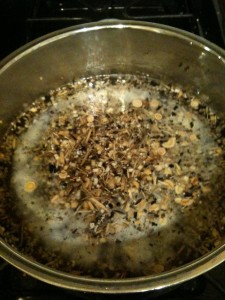There were so many dishes that I fell in love with during my time working in India, but one of my favorites is Sambar, a comforting soup that’s traditionally eaten along with fermented breads made from lentils & rice. South Indian cuisine is beautifully balanced and aromatic. It represents healing vegetarian food at its best. This is my simplified version of Sambar for home cooks who didn’t grow up cooking Indian food. I’ve removed a few of the more complicated steps without sacrificing the flavor or healing herbs.
If you’re in need of an extra boost, I’m also going to show you how to add tonic herbs to any soup or bean dish that you make without affecting the taste of the final dish. An herb is considered a tonic when its action is gently strengthening to the body over time. It makes you stronger in the same way that exercise helps you to build muscle and endurance. Tonics are not stimulating; they work gradually and gently. You can skip the tonic herbs and just make the Sambar on its own, or you can use the tonic herb recipe any time that you’re making soup or cooking beans.
South Indian Sambar with Tonic Herbs
A decoction is an herbal preparation made by cooking herbs in water at a high temperature for at least 20 minutes. This preparation is used for tough roots and is a favored preparation in Traditional Chinese Medicine. Boiling the herbs this way makes sure to extract all the healing constituents from within fibrous dried roots.
Tonic herb decoction:

decocting the herbs
2 TBSP each of:
- Cut Astragalus root, dried
- Eleutherococcus senticosus root, dried
- Burdock or Dandelion root, dried
Step 1. Add tonic herbs to 3 cups of filtered water and bring up to the boil. Cook at a rolling boil until the liquid has reduced by half.
Step 2. Cool and strain.
Step 3. To add tonic herbs to any soup or bean dish, simply replace some of the cooking water or vegetable broth called for in the recipe with your finished decoction. This blend is very mild tasting (though if you use Dandelion root you might get a hint of a bitter taste in the final product.) If you use it to cook beans or in soup you’ll notice almost no change in the flavor of your dish.
For the Sambar:
1 cup yellow split peas
1 tsp turmeric
1 tbsp coconut oil
1 TBSP fenugreek
1/2 TBSP cumin seeds
1TBSP fresh ginger root, minced
1 clove of garlic (2 if they’re small)
1 TBSP coriander powder
1TBSP cumin powder
one large tomato, diced
one bunch cilantro leaves, chopped
fresh lemon or lime juice
Directions:
1.) Bring 3.5 cups of water to a boil. If adding tonic herbs, replace the water with your decoction. Add 1 cup yellow split peas (rinsed) and 1 tsp Turmeric to the water/decoction.
2.) Bring water and beans to a boil. Cover and reduce heat to a simmer. Cook for about 45 minutes until split peas are soft. This step can be done a day in advance.
3.) Add coconut oil, fenugreek, cumin seeds, garlic and ginger to the bottom of a large pot. Cook over medium heat until fragrant–about 1-2 minutes.
4.) Add coriander & cumin powders. Stir together until warmed through the oil before adding the chopped onion.
5.) Add the diced tomato to the pot, along with 2 qts of water. (Truthfully, I don’t measure this precisely. Just use enough water to make a big pot of soup!) Stir everything together and bring mixture up to the boil.
6.) Add the chopped cilantro & the cooked split peas and cut the heat back to a simmer. Allow everything to simmer together for about 15 minutes until the flavors are combined. Finish with a squeeze of fresh citrus juice and serve topped with a little fresh cilantro.

